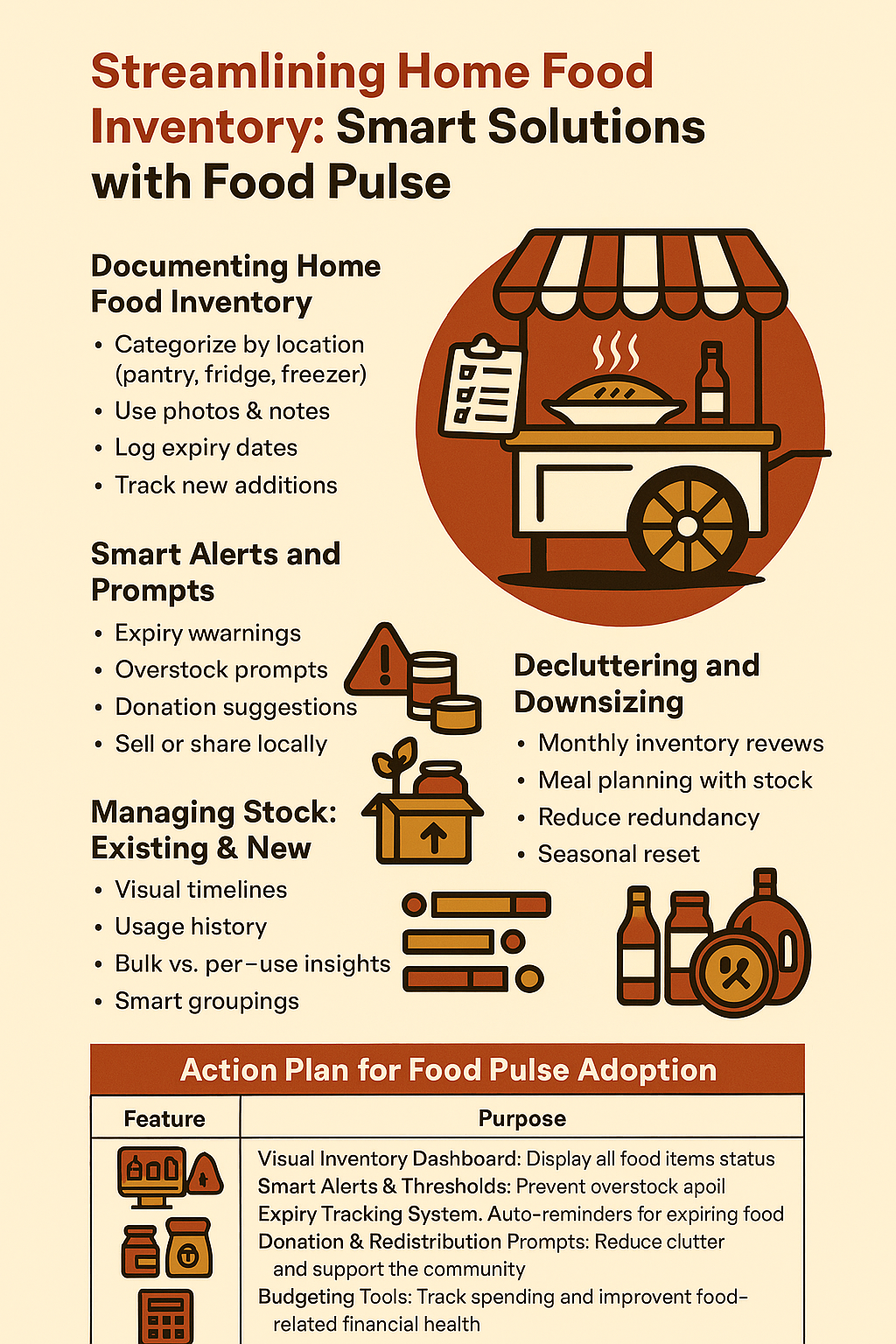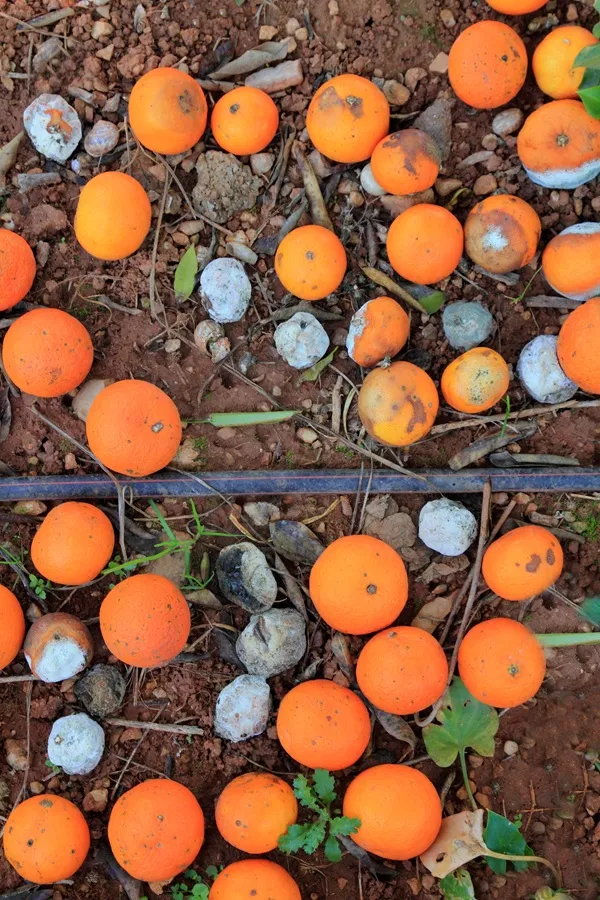Table of Contents
🧠 OVERVIEW:
🥫 Streamlining Home Food Inventory: Smart Solutions with Food Pulse
In today’s fast-paced world, households and stores alike face challenges in managing food stock efficiently. From forgetting what’s in the pantry to letting items expire unnoticed, poor food tracking contributes to waste, cost, and clutter. Food Pulse, a smart management solution, can revolutionize food tracking with technology-driven features tailored for sustainability and savings.
📸 Documenting Home Food Inventory
To create a comprehensive record of all food items, consider these organized procedures:
- Categorize by Location: Divide inventory by storage areas—pantry, fridge, freezer, shelves.
- Use Photos & Notes: Photograph each area or shelf and label images with item names, quantities, and categories (spices, grains, canned goods).
- Log Expiry Dates: Record “best-before” and expiration dates; color-code the urgency (e.g., red for near expiry).
- Track New Additions: Each time a new item is added, use the app or system to log it in real-time with a picture and description.
- Stock Threshold Alerts: Set minimum and maximum stock levels per category; trigger alerts when items fall below or exceed thresholds.

🚨 Smart Alerts and Prompts
Integrate automatic alerts to reduce waste and improve decision-making:
- Expiry Warnings: Reminders for items nearing expiration.
- Overstock Prompts: Notify users when there's excess of an item (e.g., five bottles of ketchup? Time to pause!)
- Donation Suggestions: Prompt donation of surplus non-perishables before they expire.
- Sell or Share Locally: Facilitate community exchanges or garage sales for unused dry goods.
🧹 Decluttering and Downsizing
Keep food spaces efficient and manageable:
- Monthly Inventory Reviews: Set reminders to audit shelves and reduce unused items.
- Meal Planning with Stock: Suggest recipes using what’s already available.
- Reduce Redundancy: Flag multiple items of the same kind and advise on usage or distribution.
- Seasonal Reset: Encourage a seasonal purge—donate, compost, or share.
🛒 Managing Stock: Existing & New
Food Pulse can design a dashboard to manage both existing and frequently added items:
- Visual Timelines: Track each item’s “lifespan” from purchase to consumption.
- Usage History: Show how often an item is used and replenish accordingly.
- Bulk vs. Per-Use Insights: Recommend quantity adjustments based on past usage patterns.
- Smart Groupings: Group complementary items for batch cooking or themed meals.
💰 Saving Money While Reducing Waste
Empower users with financial and sustainability-focused features:
- Cost Per Use Calculator: Break down each item’s cost over its usage life.
- Waste Reduction Reports: Show how much waste has been avoided each month.
- Budget Planning Tools: Recommend purchases based on seasonal deals and pantry needs.
- Eco-Friendly Tips: Share ways to reuse containers and reduce packaging waste.
✅ Action Plan for Food Pulse Adoption
Food Pulse could offer a comprehensive ecosystem with these core features:
| Feature | Purpose |
|---|---|
| Visual Inventory Dashboard | Display all food items with images and status |
| Smart Alerts & Thresholds | Prevent overstock and spoilage |
| Expiry Tracking System | Auto-reminders for expiring food |
| Donation & Redistribution Prompts | Reduce clutter and support the community |
| Budgeting Tools | Track spending and improve food-related financial health |
| Recipe Integrations | Suggest meals using in-stock ingredients |
| Monthly Reports | Provide insights on usage, cost, and waste saved |
🎯 Objectives:
- Document all food items at home/store with location, images, expiry, alerts
- Track what exists, where, when bought, and when it should be used
- Prompt timely use, donation, or sale of items to reduce waste
- Reduce overspending, duplication, and clutter
- Improve overall food efficiency and cost savings
✅ ACTIONS & PROCEDURES FOR USERS
📷 1. Document Every Item
- Scan or manually input every food item entering the home
- Include:
- Name, brand, size/quantity
- Location (e.g., fridge, freezer, cabinet, garage shelf)
- Photo of the actual item or packaging
- Expiry/Best Before/Use By date (or "unknown")
- Date of purchase or entry
- Notes (e.g., opened date, allergies, preparation tips)
🧊 2. Categorize by Storage Location
- Group items by:
- Pantry
- Fridge
- Freezer
- Dry Storage
- On-the-go (e.g., snack bag, car)
- Display inventory per location for easy reference and tracking
🔔 3. Set Smart Alerts
- Expiry Alerts: Based on best-before/use-by dates
- Stock Threshold Alerts: Too much or too little of an item
- Rotation Reminders: Use older items first (FIFO - First In, First Out)
- Clutter Alerts: Too many of same type (e.g., 7 peanut butter jars?)
♻️ 4. Prompts to Act
- Donate: Nearby food banks or neighbors
- Sell: Local marketplace or surplus-sharing groups
- Cook: Recipe suggestions using soon-to-expire ingredients
- Preserve: Tips for freezing, drying, pickling, or repurposing
- Batch Cook/Share: Use excess to prepare meals and share
🧾 5. Routine Inventory Audit
- Weekly or monthly reminders to:
- Review unused items
- Update items as “used,” “gone bad,” “donated,” or “sold”
- Re-evaluate storage efficiency
🧩 FOOD PULSE FEATURE PLAN
📦 A. Existing Stock Manager
- Add items manually or by scanning barcodes
- Location tagging and photo upload
- Smart categorization (type, perishability, storage needs)
- Editable details (expiry, quantity, notes)
➕ B. New Stock Entry System
- Seamless integration from shopping list to pantry
- Add item → assign to location → add purchase price, quantity
- Attach receipt image or vendor info
- Auto-fill estimated expiry based on food type
🧠 C. AI-Powered Optimization
- AI suggests:
- Meals to cook based on pantry
- Items to donate/sell
- Quantity to restock
- Seasonal alerts (e.g., extra fruits in summer = prep smoothies, freeze portions)
- Detects waste trends: “You’re discarding spinach often. Should you buy less or switch to frozen?”
📊 D. Usage & Waste Analytics
- Graphs and reports:
- What’s used regularly
- What’s wasted frequently
- Cost of food wasted
- Savings from smarter usage or donations
🛍 E. Smart Shopping Cart Features
- View items grouped by:
- Date of planned purchase
- Vendor
- Quantity
- Unit and total price
- Buying for whom
- Bought by whom
- Notes (e.g., “use for school picnic”)
👨👩👧👦 F. Multi-User Household Mode
- Allow family or roommates to:
- Add/update stock
- Mark items as used
- Share responsibilities (e.g., assign donation tasks)
- View alerts and suggestions
- Avoid duplication
🛠 PROCEDURES TO MANAGE & REDUCE HOME STOCK
1. FIFO Rule Everywhere
- Always place new items behind older ones in storage
- App can guide users on what to consume first
2. "Eat Me First" Box
- A physical or digital label for items near expiry
- AI can create a daily/weekly Eat-Me-First list
3. Clutter Management Tips
- Detect duplicate or overstocked items
- Show items not used in over 60 days → suggest action
- Prompt user to “use or lose” items
4. Event-Based Planning
- Before vacations: Recommend pantry clean-out or donation
- Holidays: Show what’s commonly overstocked → adjust shopping
🎯 OUTCOMES
| Goal | Action | Feature |
|---|---|---|
| Reduce Waste | Smart expiry & clutter alerts | AI + Notifications |
| Save Money | Plan shopping by actual need | Inventory → Shopping List |
| Stay Organized | Tag item location with photos | Pantry Map |
| Encourage Sharing | Donation & selling suggestions | Share/Donate Modules |
| Boost Awareness | Analytics on waste & savings | Dashboard |









